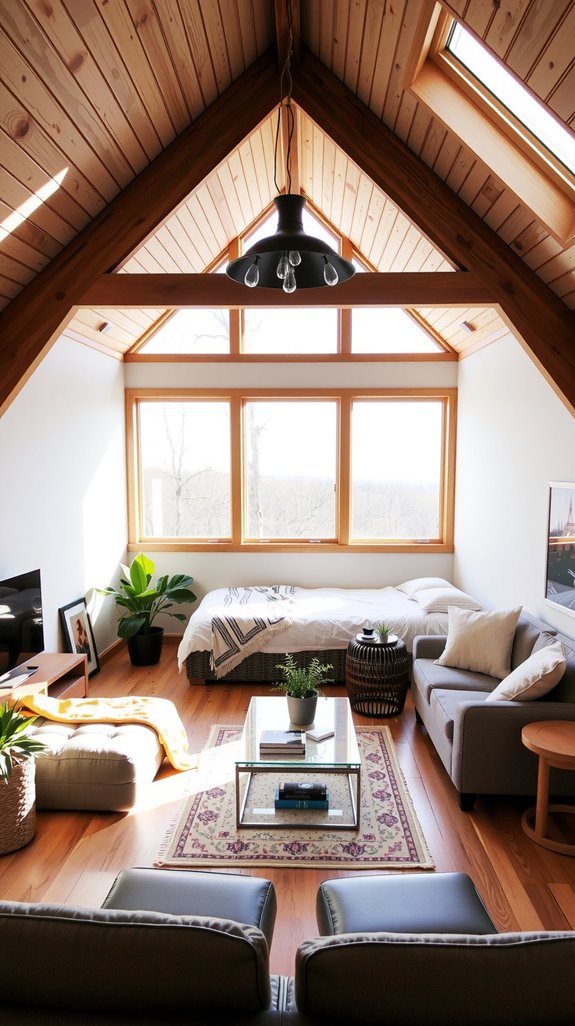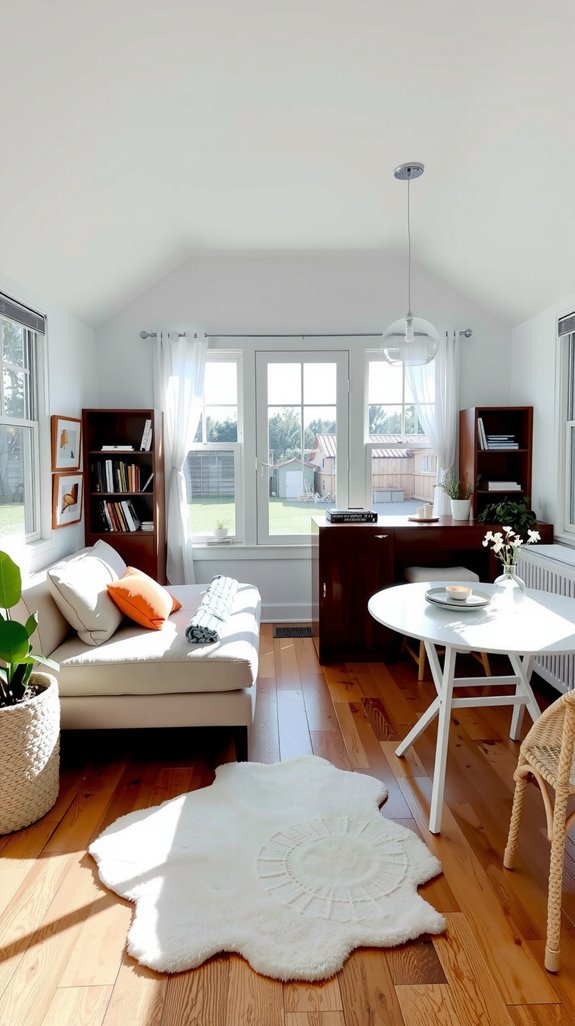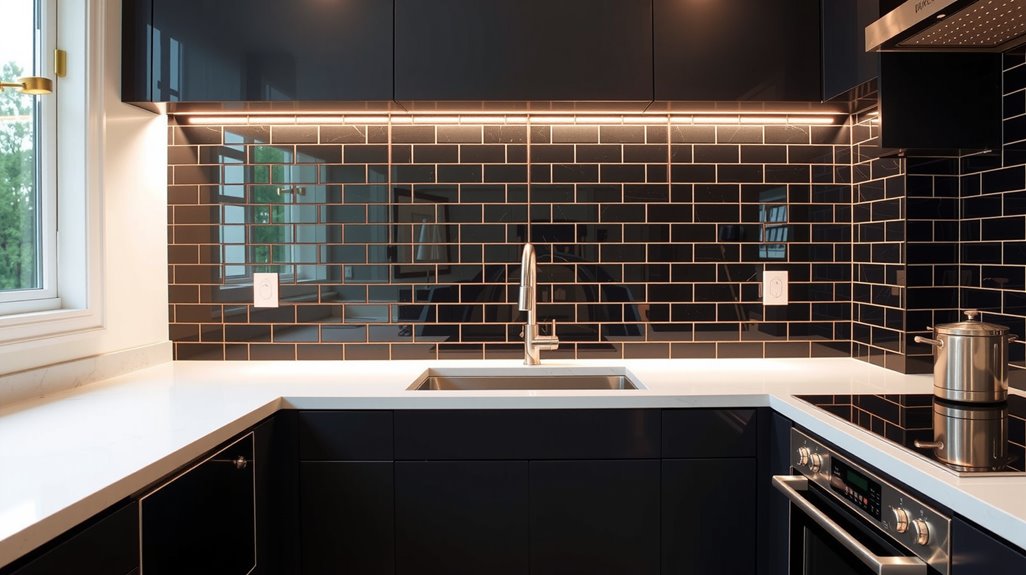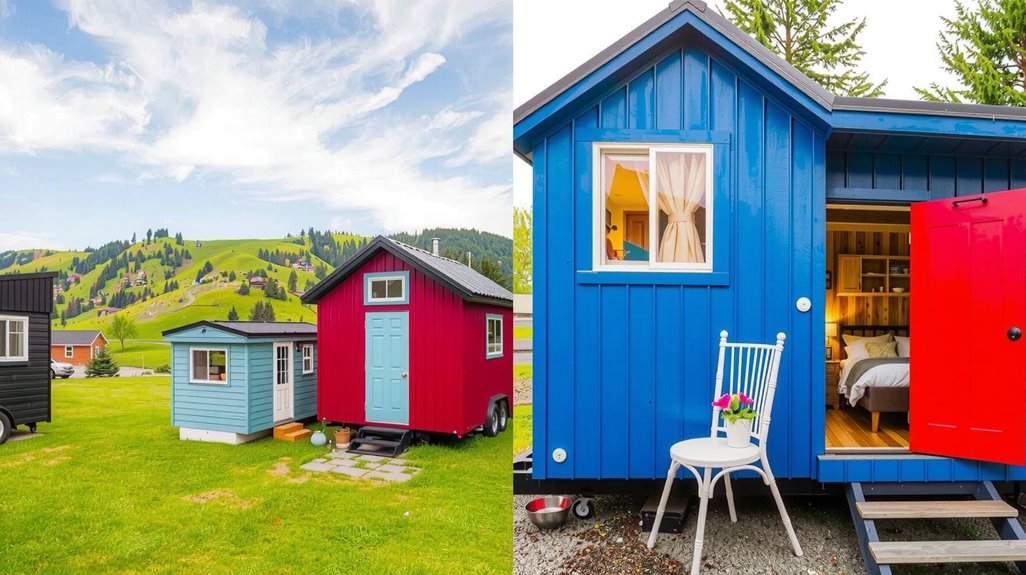Picture yourself stepping into a sunlit space where every square foot serves a purpose, and walls seem to dissolve into possibilities rather than limitations.
Youve likely heard that tiny houses require sacrifice, but the truth is quite different. Smart design transforms compact living into something remarkably beautiful, blending innovation with intention.
These seventeen strategies reveal how you can create a home that’s both functional and visually stunning, proving that less space doesn’t mean less style.
Key Takeaways
- Open floor plans and vaulted ceilings create visual spaciousness while multi-purpose furniture like Murphy beds maximizes functionality.
- Natural light through skylights and expansive windows combined with light-colored walls makes small spaces feel larger and brighter.
- Vertical storage solutions and floor-to-ceiling built-in cabinetry transform unused space into valuable organization areas.
- Outdoor living spaces with sliding glass doors effectively double usable square footage and enhance indoor-outdoor flow.
- Custom features like reclaimed wood paneling and modular partitions add character while maintaining adaptable, personalized living environments.
Embrace Open Floor Plans to Maximize Space and Flow

When you’re working with limited square footage, open floor plans become one of your most powerful design tools.
Eliminating walls creates visual continuity, allowing your eye to travel unobstructed rather than stopping at barriers. This design approach reduces construction costs while making spaces feel exponentially larger.
Multi-use areas replace segregated rooms transforming your tiny house into an expansive, flowing environment that maximizes every inch.
Open design encourages the creation of multifunctional living areas that serve multiple purposes throughout the day.
Install Vaulted Ceilings for Dramatic Vertical Volume

Vaulted ceilings transform cramped quarters into expansive sanctuaries by harnessing vertical space that would otherwise remain trapped in your roofline.
The upward sweep draws eyes skyward, creating perceived spaciousness without expanding your footprint. You’ll gain opportunities for clerestory windows and skylights that flood interiors with natural light while maintaining privacy.
Lighter paint colors maximize this vertical volume by reflecting natural light throughout the space, preventing the cathedral effect from feeling heavy or cave-like.
However, consider increased heating costs and maintenance challenges when accessing high windows or fixtures, before committing to this dramatic architectural feature.
Design Multi-Purpose Rooms for Maximum Functionality

While vertical expansion maximizes overhead potential, horizontal space demands equally strategic planning to accommodate life’s varied activities within limited square footage.
You’ll achieve this through convertible furniture like Murphy beds and sofa beds, which transform single rooms between sleeping and living functions.
Use rugs and lighting to define distinct zones without permanent walls, while ottomans with hidden compartments and sofas with lift-top storage eliminate clutter, while serving multiple purposes simultaneously.
Consider wall-mounted desks that fold away when not in use, providing essential workspace without permanently consuming valuable floor area.
Integrate Hidden Storage Solutions Throughout Your Home

Because every square inch matters in a tiny house, hidden storage transforms otherwise wasted space into functional repositories for your belongings.
Install platform beds with built-in drawers, utilize trap doors for under-floor compartments, and maximize staircases with pull-out cabinets.
Convert wall cavities into concealed closets, add storage ottomans that double as seating, and transform awkward nooks into organized cubbies with hooks and shelving.
Choose Clean Lines and Neutral Color Palettes

When you’re designing a tiny house, clean lines and neutral color palettes form the foundation of a space that feels both larger and more livable than its actual square footage.
Horizontal and vertical furniture lines guide your eye smoothly through rooms, while whites, soft grays, and pale beiges reflect light to make walls visually recede.
This creates an airy atmosphere that transforms compact dimensions into intentionally serene environments.
Maximize Natural Light With Expansive Windows and Skylights
Natural light transforms tiny houses from cramped quarters into bright, welcoming sanctuaries that feel remarkably spacious.
Install floor-to-ceiling windows and strategically placed skylights to flood your interior with daylight from multiple angles. Choose energy-efficient glazing to balance illumination with thermal comfort, and incorporate sheer window treatments that preserve privacy while maximizing light penetration.
Light-colored walls and reflective surfaces amplify brightness throughout your compact space.
Incorporate Biophilic Design Elements for Wellness
While tiny houses present undeniable spatial constraints, biophilic design transforms these compact dwellings into wellness-enhancing environments that fulfill your innate need to connect with nature.
Integrate living walls and vertical gardens that function as space-saving art installations. Choose natural materials like timber and stone for foundational elements, while incorporating organic forms and curved lines that mirror patterns found in nature, reducing stress and enhancing creativity.
Install Wall-Folding Beds and Murphy Beds
Space-saving furniture represents the next logical step after optimizing your tiny house’s wellness features, and Murphy beds deliver unmatched floor space recovery in compact living environments.
You’ll need to locate wall studs using an electronic stud finder, then secure L-brackets inside the cabinet to three studs with 2½-inch wood screws.
Install gas spring pistons and locking mechanisms for safe operation, ensuring you’ve measured adequate clearance, approximately 90 inches for queen beds.
Utilize Vertical Storage From Floor to Ceiling
When floor space becomes scarce in your tiny house, you’ll find that vertical storage transforms walls and ceilings into valuable real estate.
Wall-mounted shelves, hanging racks, and overhead storage can increase your living space by up to 30%.
Install hooks from floor to ceiling for coats and bags, add pegboards in kitchens for utensils, and use ceiling-mounted organizers to keep floors clutter-free, while maximizing functionality.
Add Outdoor Living Spaces to Extend Your Square Footage
Your tiny house doesn’t end at the front door, and creating outdoor living spaces can effectively double your usable square footage without expanding the physical structure.
Consider adding a deck or patio for seamless indoor, outdoor flow, establishing an outdoor living room with weather protection, or incorporating vertical gardens to maximize greenery.
Multifunctional furniture and window boxes further enhance these spaces while maintaining efficiency.
Blur Indoor-Outdoor Boundaries With Sliding Glass Doors
Sliding glass doors stand among the most transformative design elements you can incorporate into a tiny house, serving as a bridge between your interior living space and the outdoor areas you’ve carefully developed.
Their expansive glass panels flood rooms with natural light while creating seamless connections to patios and decks. They operate on tracks without requiring swing clearance, maximizing your usable floor space, while maintaining modern aesthetics.
Invest in Smart Home Technology and Automation
As tiny homes continue maximizing every square inch, smart technology transforms how you control and interact with your living environment, delivering unprecedented convenience within compact footprints.
Smart thermostats learn your habits for efficient climate regulation, while automated lighting adjusts based on occupancy or time of day.
Voice-controlled devices, smart plugs, and centralized hubs streamline operations, reducing clutter and energy consumption, while enhancing security through remote monitoring capabilities.
Select Multi-Functional Furniture Pieces
Multi-functional furniture pieces represent one of the most effective strategies for maximizing livability in tiny homes, where every item must justify its presence by serving multiple purposes.
Invest in ottomans with hidden storage, sofa beds that convert from seating to sleeping areas, and Murphy beds that fold into walls.
Wall-mounted fold-out tables provide workspace without consuming floor space, while stackable chairs store vertically when you’re not using them.
Create Custom Built-In Cabinetry and Shelving
Custom built-in cabinetry transforms wasted space into valuable storage while creating a streamlined aesthetic that makes tiny homes feel larger and more organized.
Building cabinet boxes on-site allows you to extend storage floor-to-ceiling, utilize rear walls as backing, and convert recessed foot spaces into functional drawers.
You’ll maximize vertical space with tall cabinets reaching 84 or 96 inches ensuring every square inch serves a purpose.
Use Sustainable and Natural Materials
When you choose sustainable and natural materials for your tiny house, you’re making a decision that extends far beyond aesthetics.
You’re reducing your environmental footprint while creating a healthier living space.
Reclaimed wood, bamboo flooring, and cork provide durability without off-gassing VOCs.
Hempcrete offers superior insulation while sequestering carbon, and recycled steel delivers structural strength with 58% less CO2 emissions than virgin materials.
Design Flexible Spaces With Modular Partition Systems
In tiny houses where every square foot demands careful consideration, modular partition systems transform rigid layouts into adaptable living environments that evolve with your changing needs.
These lightweight units assemble without tools in minutes, allowing you to create temporary rooms, privacy pods, or distinct zones.
Choose from materials like frameless glass, wood, or fabric panels that maintain light flow while optimizing space and complementing your aesthetic preferences.
Personalize Your Tiny Home With Unique Finishes and Decor
Your tiny home’s finishes and decor serve as the primary expression of your personality within a compact footprint, making each selection doubly important.
Consider Venetian plaster for textured walls, tongue and groove pine boards for warmth, or reclaimed wood paneling that adds character while supporting sustainability.
Integrate built-in furniture like storage staircases and convertible couches to maximize functionality without sacrificing style, or visual appeal.
Conclusion
You’ve discovered that small living doesn’t mean sacrificing style or comfort. These seventeen ideas transform your tiny house into an infinitely spacious retreat through smart design choices, efficient storage, and thoughtful materials. By embracing open layouts, custom built-ins, and sustainable finishes, you’ll create a home that’s both functional and beautiful. Your compact space can reflect your personality while maximizing every square inch. Start implementing these strategies today and watch your tiny house become the sanctuary you’ve envisioned.



